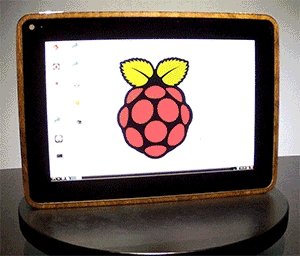Our assignment from this week was to propose and start planning a final project. For me, it was almost an exercise in wanting to do everything for long enough to not actually do anything. Finally, I came across a homemade tablet computer known as the PiPad (by Michael K Castor for Maker Fair Bay Area 2013) and immediately knew that's what I wanted to make. Michael was able to make the PiPad in 2 weeks, which fits well with how much time we have this semester, and as a project it combines aspects of computer-controlled machining and electronics. I'd also consider molding and casting to make a case. Here it is in all its glory:

Michael cut the case from 1/2" Baltic Birch Plywood and used a 1/16" carbon fiber sheet as the backing material. The PiPad features a 10,000mAh battery (~6 hours battery life), a capacitive touch screen, WiFi and Bluetooth modules, USB hubs, a Raspberry Pi Model B, and a headphone amplifier. Everything is readily available from Amazon, except for the 10" touch screen which is currently sold out from the supplier that Michael used (chalk-elec.com). My ability to obtain this piece will determine whether or not I can make the PiPad as a final project, so here's to hoping that I can track it down before the end of November!
I discovered the PiPad only shortly before this proposal was due, so once I settle on the changes that I want to make I'll be ready to upload a nice 3D model with all the appropriate holes cut for ports. As it stands, there are a few things I'd like to do differently. First, I'd like to use a different battery because right now the height of the battery is what is setting the height of the case. I would like the overall tablet to be thinner, so this will either require taking the same battery out of its case or just finding a smaller battery with similar performance. I'd also like to add a camera, because what's the point of having any device if it can't take pictures of my cat? Lastly, when Michael test runs the media center software XBMC (well, RaspBMC) he finds that it can predictably be a bit slow when playing back high resolution videos. There are also some issues that prevent the touch screen from working properly in RaspBMC, which I would prefer to solve. As far as single board computers go, it seems that one of the HummingBoard models may be able to outperform the Raspberry Pi Model B which could result in smoother video playback. I need to do more research to verify this.
Update 9/28/2014
This past week, thanks to the 3D printing assignment, I finally became comfortable enough with SolidWorks to tackle an animated assembly of the PiPad case moving from fully closed to fully open. It's still pretty simple, but I'm happy with my progress. The assembly is composed of: top and bottom stained wooden pieces connected by 2 brass hinges, each containing 4 rare-earth magnets for a tight closed position. Additionally, the top piece contains the embedded capacitive touch screen and the bottom piece contains an embedded backing material of carbon fiber. I have not yet modeled the electrical components that will sit inside the case. I've linked the animation below: